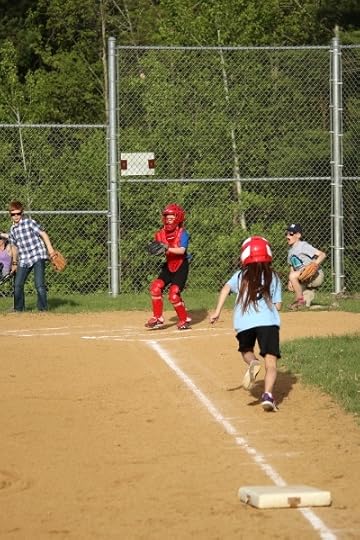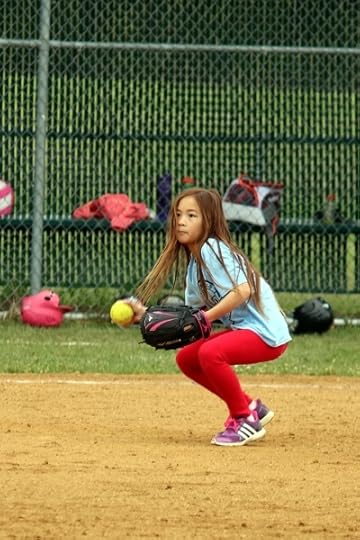Chad Orzel's Blog, page 2
June 1, 2017
Nerd Parenting Update
We took a rare long weekend to go to a family party for Memorial Day at my parents’ (Kate and the kids always get the day off, but I usually have to teach; this year, I’m doing a team-taught class, and the other person was willing to cover my Monday spot), thus the lack of a weekly update post. The delay, however, allows for some quality nerd-parenting content, so it’s a win all around…
SteelyKid’s third-grade class has been doing long-ish projects approximately monthly through the year, and the May project was to design and make a board game based on a book. SteelyKid picked the Bone graphic novels, which she and a bunch of her classmates tore through earlier in the year, and she finished the game early this week. She’s very proud of how it came out:
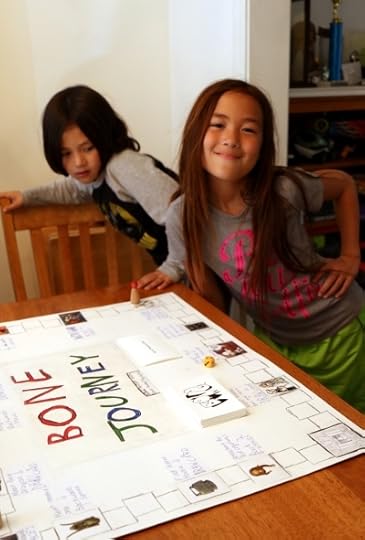
SteelyKid mugging with her board game.
This is not without justification, as she put a lot of thought into it, and it came out really nicely:
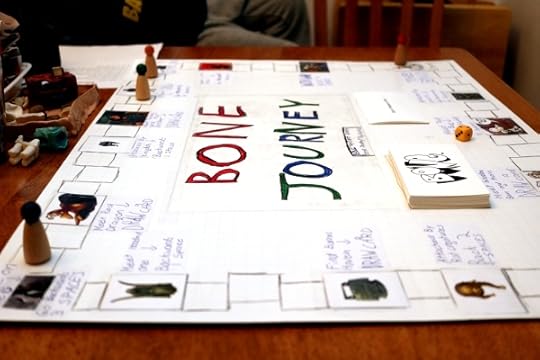
SteelyKid’s board game based on the Bone graphic novels.
(Obviously, she had a bit of help from us in finding and printing out images from the books, but the concept and general design are all her…)
We play-tested it last night, and The Pip won the first game, with SteelyKid coming in second. She’s taking it in to school today, and very excited to show it to her friends.
And so the Little Dude isn’t left out, he has also provided some quality nerd-parenting moments. SteelyKid’s work on the game pushed well past bedtime on Tuesday night, and The Pip was getting restless, so I offered to go upstairs and read with him. To my surprise, he accepted enthusiastically, mostly because we’ve started reading the Dragonbreath series by Ursula Vernon.
SteelyKid read these a while back, and I’ve been jokingly calling the kids “Cousin Spencer” whenever they critique my playing of video games. The Pip is old enough now to get the books, so we started the series, and he was very fired up for it. I have him read the dialogue bubbles on the comic-style pages that are scattered through the books, and I read the regular prose sections. We finished the first book last night, and he asked me to go get the second volume from SteelyKid’s room, even though we weren’t going to start it right away, just so he could see it and have it in his room for tonight.
The Pip started kindergarten at a lower reading level than SteelyKid did for a variety of reasons, chiefly that his birthday is three months later in the year than hers, so he was starting younger. He’s made remarkable progress, though, and is very smug about being a couple of reading levels past the goal for the end of the year. This has largely been driven by reading guidebooks about Pokemon and, more recently, Skylanders, which has done wonders for his reading but is not a real thrill for whichever parent has to read lists of character attacks to him at bedtime. Broadening his literary interests to some quality books with actual plot is a huge win.
So, it’s been a good week for nerd parenting. And now, I have page proofs of a couple of forthcoming things to review, so I need to go somewhere with no wi-fi for a while…
May 25, 2017
Long-Overdue Photo-a-Day Wrap-Up
During my sabbatical last year, I decided to try to do a photo-a-day project, taking and sharing at least one good picture a day of something or another. The strict photo-a-day format fell victim to my general busy-ness and disorganization, but I did eventually complete the whole thing. In the final post of the series, I said I might have some wrap-up thoughts in a few days; that was several months ago.
Every time I need to clear some disk space, though, I’m reminded that I left that hanging, so I finally did something in the direction of a summative post, by uploading all the edited pictures from the project to a Google Photos album. There are way more than the promised 366 photos in here, because there were sometimes multiple images on a single day, and some others are photos I took and never used for anything.
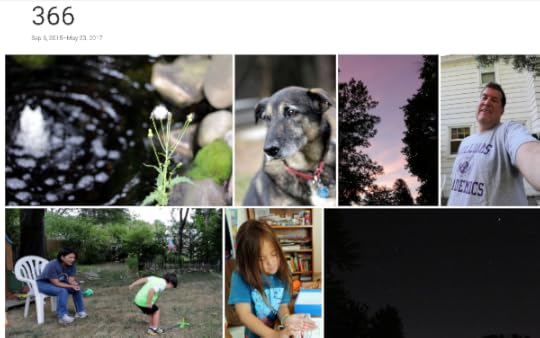
Screen shot of the Google Photos album of my photo-a-day pictures.
(That photo of Emmy in the first row still makes me a little sad…)
So, looking back on this, what are my thoughts?
I think it was definitely worthwhile, especially in the earlier part when I had more time to play around and think about what pictures to take. I learned a lot about the camera and what sort of shots work well, so I take somewhat fewer total pictures to get a handful of good ones these days. (Obviously, for things like SteelyKid’s softball games, I’m still doing a lot of burst-mode shooting in hopes of getting a really good moment. For landscape-ish things, though, I feel like I have a better sense of what will work, and don’t waste as many shots trying to get stuff that never turns out right.
It’s also interesting to look back at that whole collection of stuff, and remember what a busy year that was. We had a bunch of out-of-town trips, including a Disney cruise with the kids and a trip to Rome for a friend’s wedding. (There are many more Rome pictures on Google Photos, in other albums– I only pulled a few for the 366 project…)
Excluding the cute-kid photos (of which there are many) and the science-of-photography experiments, there’s a reasonably consistent aesthetic to the kinds of pictures I liked enough to include in this. I’ve gotten used to shooting mostly with the 22mm “pancake” lens, which has a large aperture and a large-ish field of view. It’s a fixed length, which means no zoom, but the speed factor mostly makes up for it. I’ve been switching back and forth between that and the telephoto lens lately, because SteelyKid’s playing softball again, and screwing around with the camera keeps me from getting too bored at the games.
There were a couple of things I had hoped to do, but never really found the time, mostly involving processing. I was going to spend a day or so taking photos with an eye toward making them black and white; there are a couple of B&W shots in the album, mostly where the lighting conditions made it difficult to get a decent color image. I thought it might be fun to try to do that deliberately; still do, really, but it’s hard to find time.
I also wanted to get some time to play around more with GIMP (my image-processing program of choice, for quite a few years now) and try more processing than just cropping and color-correcting. In particular, I’ve never done much with selectively processing parts of images, or trying to edit stuff out of photos. It’d be nice to know how to do those things, because people who know what they’re doing get some cool effects that way, but again, it’s hard to find the time.
Anyway, Looking at that whole collection, I’m pleased to see that the number of real duds is pretty small. And it was a lot of fun to spend time walking around specifically looking at things as potential photographs; I need to do more of that.
And that is pretty much all I have to say about that…
May 21, 2017
Kids and Construction Update
The big development of this week is that construction started on the Great Chateau Steelypips Renovation of 2017. We’re extending one part of the back of the house about ten feet to gain a bedroom on the second floor, and gut-renovating the kitchen, dining room, and mud room. This is a massive undertaking, with a massive price tag (more than we paid for the house in 2002), and is going to be massively disruptive later this summer. Right now, it’s very exciting, because we have an excavator and giant piles of dirt in our back yard:

The Pip looking at the excavator used to dig the foundation for our new addition.

SteelyKid is Queen of the Dirt Pile.
In the first week of work, they’ve dug the hole, poured the concrete footer, built the reinforced cinderblock wall, and sealed and insulated what will be the crawl space under the new addition. Next week, they should start framing the exterior. The part where they rip out the entire kitchen won’t be for a good while yet, but I’m already kind of dreading it…
While out exploring the yard, I also got a good Kate-and-kids shot:
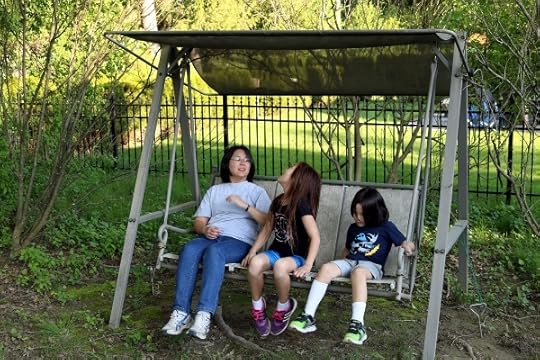
Kate and the sillyheads.
(When I saw this pose, I immediately said, “We are but poor, lost circus performers…” which is probably the only time in her life Kate has been compared to Andre the Giant… )
And to close this out, a couple of action shots, which also indicate the importance of the background in photography. This shot of Kate pushing The Pip on a tire swing, for example:
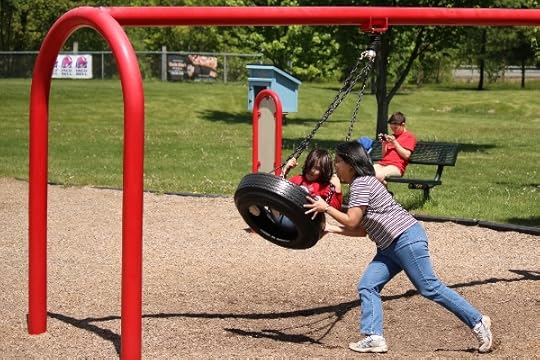
Kate pushing The Pip on a tire swing.
There’s a lot I like about this, but it would be immeasurably improved without the bored teenager checking his phone in the background. There are other shots from this sequence that would be even better, but Bored Teen Boy is even more disruptive. Alas, my photo-editing skills don’t really extend to clipping this dude out of the photo.
On the other hand, there’s this shot of SteelyKid running to home during a softball game:
In this case, the reactions of the other people in the background kind of make the shot. I have another sequence of these, without those people, and while they’re great for showing motion and the intensity of her run, they’re lacking an indefinable something that this one has thanks in part to Young Rick Astley in the background, there.
So, you know, with candid action photos, sometimes you win or lose depending on random people who have nothing to do with the shot you’re trying to get. Not the most profound lesson, maybe, but that’s what I’ve got for you this week.
May 13, 2017
Kid Growth Update
At SteelyKid’s softball game today, the Pip provided an ideal cute-kid photo to use as a springboard to some SCIENCE! Or at least, a graph… Anyway, here’s the Little Dude showing off how tall he’s gotten:
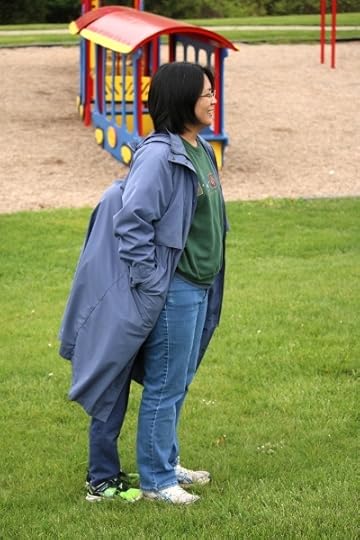
The Pip under Kate’s coat.
OK, really he’s hiding under Kate’s raincoat (after two beautiful sunny days in a row, we’re back to dreary rain today), but as a side effect of that process he’s demonstrating that he’s pretty tall. But exactly how tall?
We’re having an addition put on the back of Chateau Steelypips, and our kitchen gutted and rebuilt, so we’ve been moving a lot of stuff around to get ready. During this process, it occurred to me that this might threaten the door frame where we’ve been marking the kids’ heights at irregular intervals. So, I copied down all the values, and like any self-respecting nerd with a table of numbers, I turned them into a scatter plot:
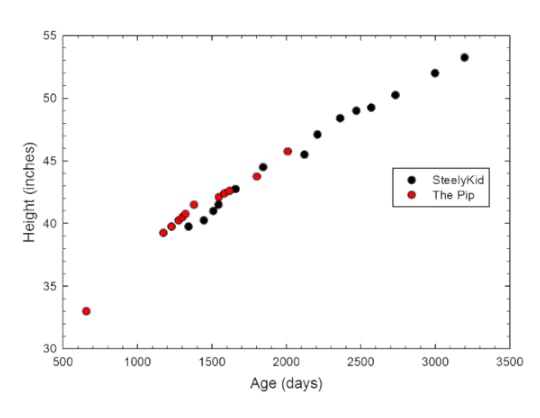
Height measurements for SteelyKid and The Pip.
There’s a good deal of scatter in these, because their idea of what “stand up straight” means is… flexible. It’s interesting to see that they’re on basically the same trend– he’s more or less exactly the same height she was at the same age, though she usually seems taller. We tend to forget how big he is, both because SteelyKid is always around, and also because when I see him with his kindergarten class he doesn’t seem that large compared to other kids. That’s mostly because his birthday is in November, so he has a lot of classmates who are nearly a full year older than him, and one or two kids with birthdays in the same part of the year are a full year older, as they waited a year to start kindergarten.
I attempted to add a line to this for median height among the US population, but that didn’t work very well, because getting the data synched up was a little awkward. I may give it another run later; in general, though, they’re a bit above the median height. I have no idea how that happened, he said, struggling to remain deadpan.
I was a little surprised by how linear that graph looks– a linear fit to SteelyKid’s height has an R2 of 0.988. Taken literally, this would lead you to conclude that she’ll pass me in height a few months shy of her 18th birthday. Of course, this fit also has her height at birth as 30 inches rather than the actual 20, so maybe we shouldn’t run too far with the linear extrapolation… The Pip’s graph hints at a bit of curve, mostly because of that first point when he was really little; a linear fit to his height (which is still pretty good– R2 = 0.96) would have him passing me at 15.
Anyway, the real action of the morning was a softball game, where SteelyKid demonstrated fielding prowess beyond her usual idle twirling and announcing “I’m BORED!!!” (when she’s in the outfield):
(That’s her after stopping a ground ball, getting up and starting to throw to first…)
And since The Pip should get a photo where you can actually see his face, I present the author photo from his forthcoming novel:
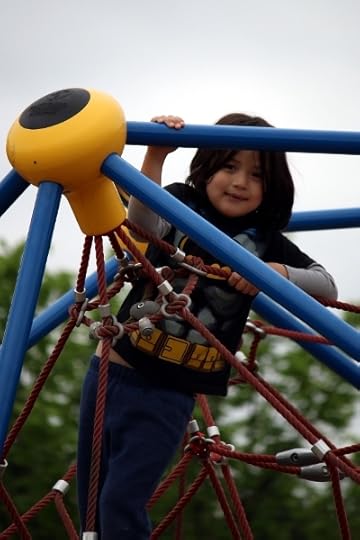
The Pip, posing for his author photo.
May 7, 2017
Kid Reading Update
For a long time now, I’ve had a Sunday routine with the kids, where we go to the Schenectady Greenmarket and then to the Open Door (which is right next to the outdoor market, and a couple blocks from the indoor location), then to lunch at Panera, and usually grocery shopping. We have a standing deal that they get one book per week free, but if they want toys or a second book, it comes out of their allowance.
SteelyKid very consistently finds something to read, but The Pip was recently in a mode where he only wanted to read Pokemon books, and the Open Door doesn’t carry those, so he would sulk. The last couple of weeks, though, he’s gotten into random other books again, and started grabbing things from the kids-book section. This is, of course, very gratifying to a bookish parent, which is also why there’s the standing book-a-week deal…
This week, SteelyKid got and devoured a new graphic novel, 5 Worlds: The Sand Warrior (I handed it to her to look at, and she just sat down and started reading. After ten minutes or so, I had to decree that we weren’t just reading the entire book there in the store…). The Pip got a book about a tech-obsessed cave boy.
In the car on the way to lunch, they were so engrossed in their books that the quiet was actually a little alarming. So I got selfie-mode photos of the two of them, to document their reading:
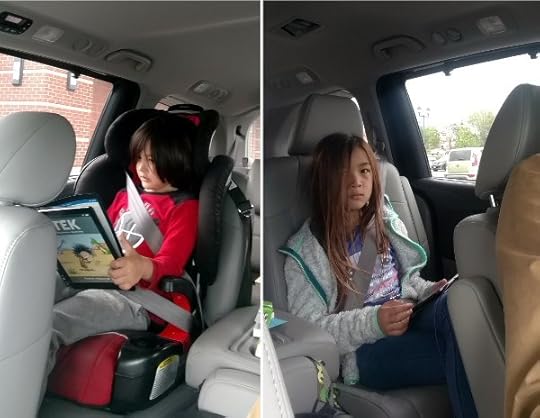
SteelyKid (r) and The Pip in the car, reading.
SteelyKid actually corrected me to say that she wasn’t reading her book in this, but doing kenken puzzles on her tablet. Which is another quiet activity I’m very happy to encourage…
So, there’s your cute-kid content for the week. They were even more entertaining on Saturday, when both of them had friends over for the afternoon, but the photos I got from that necessarily include other peoples’ kids, and I try to avoid posting those.
May 4, 2017
The Inescapable Vagueness of Academic Hiring
Inside Higher Ed ran a piece yesterday from a Ph.D. student pleading for more useful data about job searching:
What we need are professional studies, not just anecdotal advice columns, about how hiring committees separate the frogs from the tadpoles. What was the average publication count of tenure-track hires by discipline? How did two Ph.D. graduates with the same references (a controlled variable) fare on the job market, and why? What percentage of tenure-track hires began with national conference interviews? These are testable unknowns, not divine mysteries.
From the age-old Jobtracks project (ended in 2001, archived here) to those 21st-century methods such as the American Historical Association’s jobs-to-Ph.D.s ratio report, many studies have examined the employment trajectory of Ph.D. students. Few, however, have cross-referenced the arc of tenure-track success with the qualifications of the students on the market. Instead, only two types of applicant data are typically deemed significant enough to gather in these and other job reports: (1) the prestige and affluence of their alma mater, and (2) their age, race or gender.
Thank you so much for the detailed information about all the things in my application that I can’t improve.
I have a lot of sympathy for this. As a profession, academia is awful about even collecting data on critical topics, let alone sharing it with people who might make use of it. This can be maddening when it comes time to apply for jobs, or to seek tenure or promotion. The criteria for hiring and promotion seem to be shrouded in mystery, and you can never seem to get a straight answer to simple questions.
Some of this is, like every irritating thing in modern life, the fault of lawyers. Criteria are vague because giving more specific values opens the door to lawsuits from people who meet one stated criterion, but are manifestly unsuitable for some other reason– someone who has more publications than the stated threshold, say, but 75% of those are in vanity journals. If you try to get a little bit specific, you quickly find yourself having to plug stupid loopholes, with wildly multiplying criteria, until you need a degree in contract law to read the job ads.
(And if you don’t believe there would be lawsuits over that kind of nonsense, well, I’d like to request political asylum in your world. I could tell you stories about idiotic things that people have threatened to sue over. That is, I could, if it wouldn’t be wildly inappropriate for me to do so, so instead I’ll just darkly mutter that there are stories to be told…)
The bigger problem, though, is that most of the stats that could readily be reported are noisy garbage, subject to wild misinterpretation. As nicely demonstrated by the paragraphs where the author tries to highlight real data of the type he’d like to see:
However, secondary data analysis of other studies that have been generously made public can reveal clues that the job reports don’t care to. For example, a 2016 study that measured the publications and impact of STEM Ph.D. students happened to simultaneously measure the average number of their publications while in grad school, cross-referenced to their later hireability. The average number of publications for each future tenure-track hire was 0.5, a surprisingly low number that would likely be higher in humanities disciplines.
Another study from 2014 measured similar survey data with similar results, but it added that publishing rates among graduate students have been steadily increasing over time, while hiring rates have been steadily decreasing. That study placed the average number of publications around 0.8. It is clear that standards are shifting, but how much? And how do those standards vary by field?
Those numbers both registered as wildly implausible to me, so I looked up the papers, and they’re both misrepresented here. The first study, showing half a publication per tenure-track hire is restricted to Portugal, which the authors describe as “a developing higher education system” that is “still characterized by poorly qualified academics– only 68% of academics in public universities hold a Ph.D.” The number from the second study is a flat-out misquote– the 0.8 publications per student number is for publications by students who did not publish with their advisor as a co-author. Those who did co-author papers with their advisor, as is common practice in STEM fields, had 3.99 articles pre-Ph.D.; averaging them all together you get 1.88 publications before the doctorate for all the students considered in the paper, more than twice the figure quoted.
Even if you crunch the numbers correctly, though, these statistics are not all that meaningful, because acceptable publication rates vary wildly between subfields, even within a single discipline. I had a total of 5 publications before I finished my Ph.D. (though one of those was a theory paper to which my only contribution was delivering a floppy disk full of experimental data to the theorists upstairs), which is pretty respectable for an experimentalist in my field. I came into an established lab, though, and just picked up on an experiment that was already working. I know of grad students who were involved in lab construction projects who ended up with only one or two publications, but who were well-regarded scientists in the field because of the scale of the work they did building up an experiment that would go on to churn out lots of papers. In a very different field, on the other hand, a former student who went into theory had eight papers pre-Ph.D., which is more in line with expectations in his field.
And the noisiness of the data only gets worse. People working in fields like nuclear and particle physics, where papers are published by large collaborations, can end up with their names on dozens of papers, because everybody in the collaboration gets listed on every paper from that collaboration. (I don’t think grad students are generally included as full members in this sense, though junior faculty often are.) You can, of course, attempt to divide things up by subfield, but as always, the more finely you subdivide the pool, the less reliable the data gets, from simple statistics.
I’m not going to say there aren’t hiring committees doing simple paper-counting as an early weed-out step, but it’s not remotely a good metric for making final decisions.
In the end, the question comes back to a point raised earlier in the piece, namely what factors the candidate can control. Hireability is not a matter of hitting some threshold number of publications, it’s about making the most of the opportunities available to you, and being able to make a persuasive case that you have done so, and will be able to do so in the future, as a faculty member. What counts as “enough” publications to get a degree or go on the job market isn’t a bright-line rule, it’s a judgement call, and making a reasonable decision about when you have “enough” is part of the transition from student to scholar.
The factors a job applicant can control are making that central decision– what constitutes “enough,” in consultation with the advisor(s)– and making the case that the decision was a good one. When we’re doing a search and trying to separate “frogs from tadpoles,” we’re not just counting papers, we’re reading statements, and (speaking for myself) a clear and convincing research statement putting past work in context and showing how it carries through to future work carries a lot more weight than an extra paper or two on the CV.
That is, I realize, maddeningly vague. I’ve been through the process, and been maddened by it. But as comforting as it might be to have more stats about the process, that comfort would be an illusion, because most of the readily available measures are junk.
(And, of course, everything comes back to the central problem, namely the vast gulf between the number of qualified candidates and the number of available jobs…)
May 2, 2017
Physics Blogging Round-Up: April
It’s the first week of May, which means we’re due to see flowers watered by all this damn rain soon, and also a recap of the various posts I wrote for Forbes during April:
— Why Are There Too Many Papers In Theoretical Physics?: A look at the origins of “ambulance chasing” in high-energy theory, where dozens of people jump on the slightest hint of a new effect.
— A Little Luck Is Essential For Success In Science: Some historical examples of physicists who succeeded thanks to a lucky break of one sort or another.
— What Sorts Of Problems Are Quantum Computers Good For? Prompted by news of a “quantum traveling salesman” algorithm, a look at the general shape of problems where quantum computing offers a big speed-up over the best classical approaches.
— Why Do We Teach ‘Physics For Poets’ But Not ‘Poetry For Physicists’?: Some thoughts about why it is that we have students take courses in other disciplines, and how reform efforts that work too hard to appeal to non-majors might undermine the whole point of liberal education.
— What Does It Mean For ‘Science’ To Rise And Fall?: Some thoughts about cycles in the history of science as applied to particular definitions of “Science.”
A decent mix of stuff this month; some long-running obsessions popping up again, some more topical stuff. Two of these are actually very long and well-disguised subtweets, in that they spun out of thinking about kerfuffles in social media that it wouldn’t be productive to write about directly.
You may have noticed a pattern to these recaps, in that there are always five posts; that’s because my contract with Forbes pays me more if I do at least five posts in a month, so I try to hit that. It also works reasonably well in terms of workflow, because that’s just over one post per week, and that’s a decent rate for me in terms of producing fairly consistent quality without cutting too much into my other activities. I may do a navel-gazing post later about how my blogging practices have evolved over time, though…
Anyway, another month, another chunk of blogging. There was a bit of a dry spell in there in terms of material I could usefully write about, and now in keeping with tradition I find myself with an oversupply of blog-worthy material and an undersupply of time in which to write about it. Such is the glamorous life, etc.
April 30, 2017
Kid Writing Update
One of the things parents of multiple kids often talk about is how they don’t end up doing the same things with second children that they did with their first. For example, I carried the weekly Appa-for-scale photos on with SteelyKid for a couple of years, but didn’t last anywhere near that long with The Pip. Another thing I did with SteelyKid was to report fairly regularly here on cute stories she told me, and that kind of thing, which I’ve largely been failing to do with The Pip. the fact that I’ve fallen out of doing any kind of kid-blogging at all doesn’t really make this any better…
But the absence of cute-schoolwork stories doesn’t mean there hasn’t bee cute schoolwork from our Little Dude. He’s considerably younger compared to his classmates than SteelyKid was when she entered kindergarten (his birthday is in November, and kids need to be 5 by December 1 in order to start kindergarten), but he’s working really hard, and has come a long, long way this year. Here’s an excerpt from his April writing journal, on Earth Day:
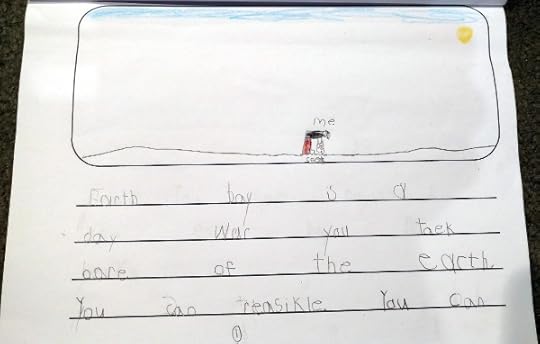
The Pip on Earth Day.
(Transcribed literally, save for fixing a couple of letters, including the continuation on the next page:)
Earth day is a day war you taek care of the earth. You can reasikle. You can reidus. You can reyus. I like earth day. Do you?
(With spelling corrected, that’s “Earth Day is a day where you take care of the Earth. You can recycle. You can reduce. You can reuse. I like Earth Day. Do You?”)
He’s also gotten really good at reading, thanks in part to his obsessive study of Pokemon cards.
His big sister also continues to have a fertile imagination; I particularly liked the story that she wrote to go with this cute-animal coloring page (which is on the back; the photo is a composite):
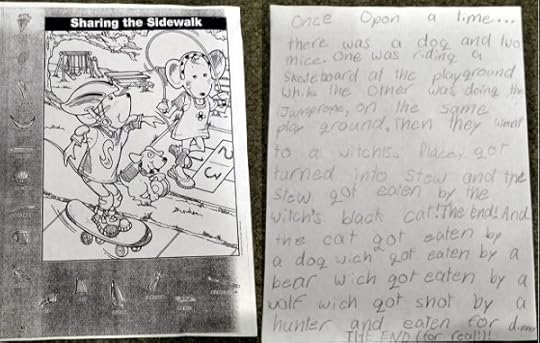
Coloring page and SteelyKid’s story that accompanies it.
The story (3rd-grade spelling transcribed as is):
Once Opon a time… there was a dog and two mice. One was riding a skateboard at the playground while the other was doing the jumprope, on the same play ground. Then they went to a witch’s place, got turned into stew, and the stew got eaten by the witch’s black cat! the end! And… the cat got eaten by a dog wich got eaten by a bear wich got eaten by a wolf wich got shot by a hunter and eaten for dinner.
THE END (for real!)!
“Wow, honey, that got a little dark,” I remarked. “Oh, everybody in the class got dark like that…” she replied airily. I’m not sure what to make of that…
Anyway, there’s your cute-kid update. I’m going to try to carve out a little time for more regular kid updates, probably on weekend mornings, because it’ll probably be a good exercise mental-health-wise.
And, for those reading by RSS, here’s the “featured image” from up top, a composite of our “cautious daredevils” (a self-description from a hike we took at the Christman Sanctuary down in Duanesburg) on the climber at the middle school playground in Whitney Point, when we were at my parents’ over Easter. These are cell-phone pictures because like an idiot I forgot my good camera, but I like having the climber as a standard reference object so you can judge their relative sizes.
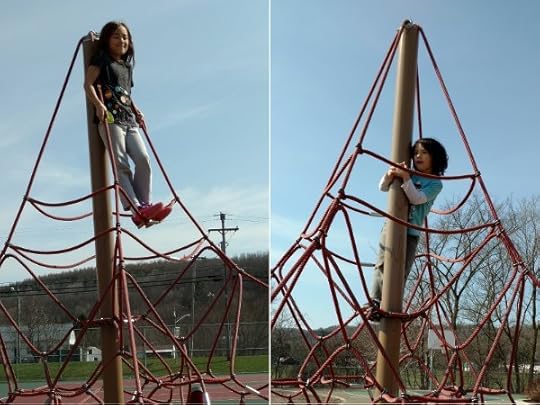
Cautious daredevils posing atop the climber.
April 3, 2017
Physics Blogging Round-Up: March
Another month, another batch of blog posts at Forbes:
— In Physics, Infinity Is Easy But Ten Is Hard: Some thoughts on the odd fact that powerful math tricks make it easy to deal uncountably many interacting particles, while a smaller number would be a Really Hard Problem.
— New Experiment Explores The Origin Of Probabilities In Quantum Physics: A write-up of an experiment using a multi-path interferometer to look for departures from the Born rule for calculating probabilities from wavefunctions.
— The Most Important Science To Fund Is The Hardest To Explain: In light of the awful budget proposal put forth by the Trump administration, some thoughts on the importance of government funding for the most basic kinds of research.
— Popular Science Writing And Our Fascination With Speculation: Prompted by the new book from Jorge Cham and Daniel Whiteson, a look at why so many pop-science books focus on what we don’t know.
— Can You Make A Quantum Superposition Of Cause And Effect?: A write-up of a new paper where they put a single photon into a superposition of A-then-B and B-then-A, which kind of makes my head hurt.
I’m pretty happy with these, though I would’ve expected more pageviews for the cause-and-effect thing. My teaching schedule is slightly lighter this Spring term, so I may be able to do a little more in-depth blogging than in recent months. Or maybe not. Come back in May to find out…
March 30, 2017
Priority Expectations and Student-Faculty Conflict
There was a kerfuffle in academic social media a bit earlier this week, kicked off by an anonymous Twitter feed dedicated to complaints about students (which I won’t link to, as it’s one of those stunt feeds that’s mostly an exercise in maximizing clicks by maximizing dickishness). This triggered a bunch of sweeping declarations about the surpassing awfulness of all faculty who have ever thought poorly of a student (which I’m also not going to link, because they were mostly on Twitter and are now even more annoying to find than they were to read). It was a great week for muttered paraphrases of Mercutio’s death speech, in other words.
These opposite extremes are sort of interesting, though, in that they both spring from the exact same core problem, namely that each side of the faculty-student relationship thinks they should be the other’s top priority, and are annoyed when they’re not.
Faculty complaints about students missing class, not handing in work, etc. in the end trace back to the feeling that class work– and specifically their class work– ought to be the single highest priority for students in that class. I realized this a few years back, when I had a horrible experience with a couple of pre-med physics classes, who were infuriating even by the standards of pre-med physics classes. What I found most maddening about this particular group was that they didn’t even try to hide the fact that my class was their lowest priority. It wasn’t just the constant requests that I adjust my due dates to work around the organic chemistry class running the same term– those are a constant with the pre-med crowd. This particular group would come to a physics recitation section in a first-floor classroom that ended ten minutes before my lab on the third floor, then leave the building to go get coffee in the campus center, and roll into lab 10-15 minutes late. The colleague who taught the recitation section was usually back in his office down the hall well before the students in the class he’d just finished teaching would stroll by on their way to lab.
(I eventually lost my temper with them, and started locking the door at the beginning of the period, only letting them in after I finished the pre-lab lecture to the students who cared enough to arrive on time. This… did not end well.)
On the student side, a lot of the complaints about faculty practices and policies boil down to the same thing in reverse– the idea that faculty need to have the needs and wants of individual students in their class as their absolute top priority. One of the most common complaints about faculty is that they’re “not available enough” and “too slow returning graded work,” both of which implicitly assume that the faculty don’t have anything else to do that’s more important than grading papers and waiting for student questions. That’s not remotely accurate, even if we restrict the scope of activities to professional duties alone, leaving out personal and family concerns. There are research papers to be written or re-written, grant proposals with hard deadlines, committee and department service tasks, and lots of other things that take faculty away from working on that specific class.
And a lot of things that seem like perfectly reasonable requests from an individual student perspective have very real costs for faculty, and for other students in the class. I’m pretty flexible about due dates and the like, but I can’t wait on one student’s homework indefinitely, no matter how good their reason for needing extra time, because it harms the other students in the class. My general practice is to make solutions available to the class as a study aid, and I can’t do that until I have all the homework that’s going to be graded.
Are there faculty whose draconian policies are an unfair imposition on students? I think so, yes. Are there students who feel entitled to excessive deference? Absolutely. (The go-get-coffee-and-come-to-lab-late thing was beyond the pale…) For the most part, though, everybody has priorities they’re trying to balance, and we’re all doing the best we can.
It’s important for both faculty and students to recognize that members of the other group are people trying to balance multiple competing priorities as best they can. Students who really like the class and want to do well can end up having to give other courses, other activities, or their personal well-being a higher priority for part (even most) of the term. And faculty who want to do right by their students can nevertheless have any number of valid reasons for drawing a line and saying “I can do this much, and no more.”
We all want our thing to be everybody else’s top priority, that’s just human nature. It’s not always going to work out that way, though, and recognizing that is the key to avoiding a lot of needless conflict.
Chad Orzel's Blog
- Chad Orzel's profile
- 89 followers


